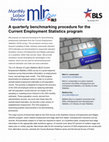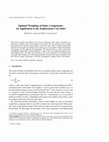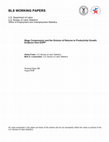Papers by Mark Loewenstein
Monthly Labor Review, Oct 20, 2020
Monthly Labor Review, 2021
Using data from the National Longitudinal Surveys of Youth 1979 and 1997, this article examines h... more Using data from the National Longitudinal Surveys of Youth 1979 and 1997, this article examines how the skill level and task content of U.S. jobs vary among workers born during the 1957–1964 and 1980–1984 periods. This article presents data on how job attributes vary by sex, race, Hispanic origin, and educational attainment as well as by performance on the Armed Forces Qualifying Test and type of occupation. It also examines the relationship between job attributes and wages.
The Journal of Economic Inequality, 2021
The original version of this article was published online with error as some of the footnotes wer... more The original version of this article was published online with error as some of the footnotes were missing. The updated footnotes are shown below: Footnote 8: "In the CES, detailed industries are divided into NAICS sectors, while CPS uses major industry groups. These classifications are not exactly 1-to-1." Footnote 9: "November saw a sharp reduction in this component of employment loss. Specifically, 5% of the lowest earnings quintile's employment loss in November is explained by a reduction in its share of employment within major industry groups, compared to the 31% that we see in the CES as of November. Further analysis of the data reveals that a major cause

Monthly Labor Review, Nov 2, 2017
We propose an improved procedure for benchmarking employment estimates from the Current Employmen... more We propose an improved procedure for benchmarking employment estimates from the Current Employment Statistics (CES) survey. The procedure involves more frequent updating of data, whereby seasonally adjusted CES estimates are benchmarked to seasonally adjusted Quarterly Census of Employment and Wages estimates on a quarterly, rather than annual, basis. We provide simulation results illustrating the advantages of the method, which can be used for benchmarking both national estimates and state and area estimates. The U.S. Bureau of Labor Statistics (BLS) Current Employment Statistics (CES) survey is a quick-response business survey that provides information on employment, hours, and earnings each month. 1 The CES program benchmarks its employee series in order to re-anchor sample-based employment estimates to full population counts. This process is designed to improve the accuracy of the CES all-employee series by replacing estimates with full population counts that are not subject to the sampling or modeling errors inherent in the CES monthly estimates. These population counts, derived from administrative records, are much less timely than the sample-based estimates, but provide a near census of establishment employment. The CES program is examining possible improvements in its benchmarking procedures. The major source of benchmark data for the CES survey is the Quarterly Census of Employment and Wages (QCEW) program, which collects employment and wage data from states' unemployment insurance (UI) tax records. All businesses subject to UI laws are required to report, on a quarterly basis, employment and wage information to the appropriate state workforce agency. UI records cover about 97 percent of nonfarm wage and salary jobs on civilian payrolls. Benchmark data for the remaining 3 percent of CES employment are constructed from alternative sources, primarily the County Business Patterns series and the Annual Survey of Public

Journal of Official Statistics, 2000
where mit is the value of the i th component and qi is the known, ®xed weight given to the i th c... more where mit is the value of the i th component and qi is the known, ®xed weight given to the i th component in the overall index. For example, I may be a price index in which case, mi is the proportionate change in price over the period for the i class of goods or services and qi is category i's share of the total budget. Naturally, if we knew the true values of the mi's, it would be straightforward to calculate the value of I . Unfortunately, we are only able to obtain an estimate of each mi. Depending on the nature of our sample, some of the mi's may be estimated much more precisely than others. The following question immediately comes to mind: Might we want to over(under) weight those components that we are able to estimate most (least) precisely? More generally, what are the optimal weights? This article develops a procedure for solving precisely this problem. We then apply our procedure to the wage component of the Employment This article considers the problem of how ...
Journal of Labor Economics, 1989
Barron et al. Í. Introduction The process by which heterogeneous workers are matched to hetero-ge... more Barron et al. Í. Introduction The process by which heterogeneous workers are matched to hetero-geneous positionsjob matchinghas received attention in research on labor turnover and wage growth (eg, Jovanovic 1979a, \979b, Harris and Weiss 1984, Mortensen 1984, ...
Journal of Labor Economics, 1987
An employer must choose a procedure for screening job applicants, a rate of hire, a training prog... more An employer must choose a procedure for screening job applicants, a rate of hire, a training program for new employees, a criterion for the retention of new employees after observing their on-the-job performance, a compensation package, and a rate of capital invest-ment so as ...
The Journal of Human Resources, 1993
ABSTRACT This paper constructs an equilibrium job-matching model where workers differ in their at... more ABSTRACT This paper constructs an equilibrium job-matching model where workers differ in their attachment to the labor force. The model predicts that workers with weaker attachment to the labor market will receive lower starting wages and lower post-training wages, and will ...
Journal of Economic Dynamics and Control, 1984
ABSTRACT

Monthly Labor Review, 2021
To measure the effects of the coronavirus disease 2019 pandemic, the U.S. Bureau of Labor Statist... more To measure the effects of the coronavirus disease 2019 pandemic, the U.S. Bureau of Labor Statistics added questions to the Current Population Survey, the main U.S. labor force survey, starting in May 2020. This article analyzes the results from questions asking people (1) whether they teleworked because of the pandemic and (2) whether they were unable to work because their employers closed or lost business because of the pandemic. We use the data on telework to refine work completed earlier in the pandemic that classified occupations on their suitability for telework. We then apply the revised classification to examine trends in telework and the extent to which working in an occupation suitable for telework shields workers from unemployment. Our results show that the pandemic resulted in a large increase in teleworking, with 33 percent of U.S. workers reporting teleworking because of the coronavirus in the period May-June 2020, before declining to a still substantial 22 percent in ...

This paper analyzes the relationship between wages and productivity during the early years of an ... more This paper analyzes the relationship between wages and productivity during the early years of an employment relationship. Data from the Employment Opportunity Pilot Project show that worker productivity grows substantially during the first two years on the job, with most of the growth in productivity occurring at the very start of the job. Correcting for measurement error and the fact that expected productivity beyond the start of the job may be folded into the starting wage if wage revisions are not instantaneous, one finds that variation in productivity is only partially reflected in wages. Not only is productivity growth stemming from human capital accumulation while on the job only partially reflected in wage growth, but starting productivity differences for workers in the same job – in large part driven by differences in relevant experience - are only partially reflected in starting wage differences. Our empirical findings can be explained by a simple model of employer – worker...

The Journal of Economic Inequality
This paper examines employment patterns by wage group over the course of the coronavirus pandemic... more This paper examines employment patterns by wage group over the course of the coronavirus pandemic in the United States using microdata from two well-known data sources from the U.S. Bureau of Labor Statistics: the Current Employment Statistics and the Current Population Survey. We find establishments paying the lowest average wages and the lowest wage workers had the steepest decline in employment and experienced the most persistent losses. We disentangle the extent to which the effect observed for low wage workers is due to these workers being concentrated within a few low wage sectors of the economy versus the pandemic affecting low wage workers in a number of sectors across the economy. Our results indicate that the experience of low wage workers is not entirely due to these workers being concentrated in low wage sectorsfor many sectors, the lowest wage quintiles in that sector also has had the worst employment outcomes. From April 2020 to May 2021, between 23% and 46% of the decline in employment among the lowest wage establishments was due to within-industry changes. Another important finding is that even for those who remain employed during the pandemic, the probability of becoming part-time for economic reasons increased, especially for lowwage workers.
Journal of Human Resources, 2005
We investigate the functional form for formal training in a wage equation and derive estimates of... more We investigate the functional form for formal training in a wage equation and derive estimates of its rate of return. The cube root fits best in our two data sets. We show that if wages are not adjusted continuously, estimating the return to training requires one lag and one lead of training. Using the cube root and a semi-nonparametric estimator,
Foundations and Trends in Microeconomics, 2006
The analysis of how individuals obtain and are paid for their skills is fundamental to labor econ... more The analysis of how individuals obtain and are paid for their skills is fundamental to labor economics. The basic idea of human capital theory is that workers and firms invest in workers' skills in order to increase their productivity, much as persons invest in financial or physical assets to earn income. Workers develop many skills through formal education not tied to an employer, but an important part of their skills are learned on the job. This paper is a survey of the recent literature on on-the-job training, both theoretical and empirical.
Economic Inquiry, 1990
How does government regulation influence the structure of industries? In the coal mining industry... more How does government regulation influence the structure of industries? In the coal mining industry increased safety can be provided with personal protection devices or with engineering controls; but the type of safety standard imposed is important because larger producers have a comparative advantage complying with engineering controls. Time series evidence indicates that the 1969 Coal Mine Health and Safety Act, by imposing engineering controls, drove out smaller, less safe mines, thereby shijting production toward larger mines. "Many of the proposals made in the name of safety have little to do with the safety of the individual miner, but a great deal to do with the vested interests of the most powerful forces in the coal industry, the large operators and the union."











Uploads
Papers by Mark Loewenstein